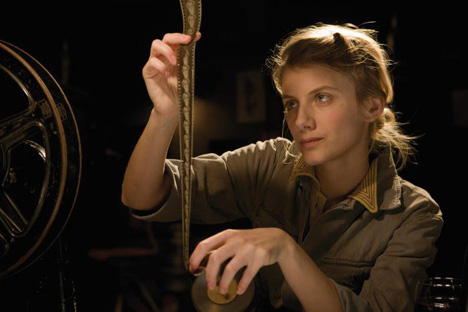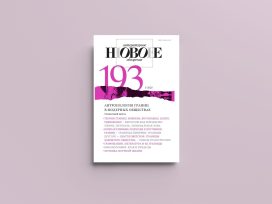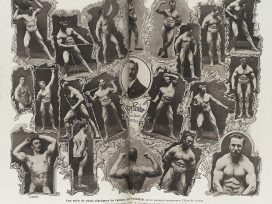The title, “The Holocaust as fiction”, might provoke misunderstanding. Clearly, I do not wish to suggest that there is anything fictional about the actual event. Yet, I do want to provoke. Focusing on artistic representations of the Holocaust, I seek to address problems and moral dilemmas that evade understanding. Can the Holocaust ever be depicted through artistic means? Can it be romanticized, as the great Polish director, Andrzej Wajda, did with his Korczak? Can it be fictionalized as the maverick American filmmaker, Quentin Tarantino, did in his bleak, violent comedy Inglourious Basterds?

A still of the actress Mélanie Laurent in “Inglourious Basterds” (2009). Source: IMDb
Thinking about the Holocaust we are forced to confront the unthinkable. Can this be done? It must be done.
Wajda’s movie depicts Dr Janusz Korczak – one of the great heroes of the Warsaw ghetto, a Jewish-Polish doctor who sought to protect about 200 Jewish orphans from Nazi persecution. Undoubtedly, the movie is both profound and important, but its meaning is open to different interpretations. What I find particularly troubling is the depiction of the moral dilemmas that Korczak faced, and what they tell us about the possibility of redemption in the face of radical evil. To explain my position, I will compare Korczak with a more recent, and far more outrageous attempt to depict the Holocaust, Tarantino’s Inglourious Basterds, as well as the hugely successful movie The Reader, directed by Stephen Daldry. To make sense of the problems that these movies raise, I will enlist Hannah Arendt, Primo Levi and Jean Amery – three key thinkers who have decisively shaped our views on European history.
The problem of artistic representation of the Holocaust is not new. We have come a long way though. When the German philosopher, Theodor Adorno, postulated that “to write poetry after the Holocaust is barbaric” (“nach Auschwitz ein Gedicht zu schreiben, ist barbarisch”), he could scarcely have imagined people making aesthetically pleasing movies about this unfathomable event. But this is what he feared. His assertion conveyed the idea that no form of representation could ever do justice to the awfulness of the Holocaust. “Through aesthetic principles or stylization”, Adorno argued, “the unimaginable ordeal still appears as if it had some ulterior purpose. It is transfigured and stripped of some of its horror, and with this, injustice is already done to the victims.” Clearly, Adorno’s concern was not simply a matter of aesthetic taste. He was convinced that the very foundations of western civilisation and the Enlightenment were implicated in Nazism’s rise.
Adorno’s dictum has been echoed by a number of survivors of the Holocaust. Elie Wiesel was adamant that “a novel about Treblinka is either not a novel or not about Treblinka”. In a similar vein, the documentary filmmaker Claude Lanzmann argued,
The Holocaust is unique […] since horror in the absolute degree cannot be communicated. To pretend that one has done so is to commit the gravest of transgressions.
Yet, if representation of the Holocaust is impermissible, how are we to remember the event? How do we communicate it to our students? And remember and communicate it, we must. Adorno revised his famous statement hinting at a way of approaching this dilemma:
Perennial suffering has as much right to expression as a tortured man has to scream; hence it may have been wrong to say that after Auschwitz you could no longer write poems.
This is the debt we all owe to people like Primo Levi. If any evidence was needed to disprove Adorno’s rhetorical ban on representation, Levi delivered it with his testimony, If This is a Man. He went through the hell that was Auschwitz with his dignity intact and managed to write a compelling testimony of his experience. This accomplishment is a tremendous source of hope. Through his writings, Levi restored our confidence in the good of man. He enabled us to restore the basic beliefs of the Enlightenment. Even after the Holocaust, or indeed, particularly after the Holocaust, we introduce our students to great thinkers and their ideas, because we believe that this is the way to improve our society and ourselves. This is the joy and purpose of teaching the humanities.
In fact, the current study is inspired by an influential Australian public intellectual and an outstanding colleague, Robert Manne, with whom I was fortunate to teach a subject about twentieth century European history at La Trobe University in Melbourne. The subject introduced students to fundamental problems of politics through great works of literature and cinema, such as Levi’s testimony and Wajda’s Korczak. Manne identified two contrapuntal strands in If This is a Man:
The formal argument of the book is that under the crushing conditions of the Nazi death camps in Poland people were turned into beasts; that those unable to adapt to this savage world were soon marked out for spiritual and physical death; that for those able to adapt there was not only unimaginable suffering but also a terrible moral price to pay: and that in the end the Germans succeeded in their infernal ambition – “the demolition of man”. Yet throughout the book there is a counterpoint, an undertow pulling in the opposite direction, which allows us to see that while all this is generally true none of it is unqualifiedly so.
One of the most moving accounts of Levi’s desire to hold on to the best aspects of man is his conversation with a fellow inmate, Pikolo, with whom he seeks to share the beauty of Dante’s poetry. To my mind, this incident amounts to the most compelling defence of humanities, as that kind of human endeavour that might appear to be useless, yet is and remains essential to our lives. The purpose of their conversation is as prosaic as it is bizarre: through Dante, Levi is teaching his friend Italian. And as he is reciting verses from Dante’s Divine Comedy, it becomes clear that – if only for a moment – poetry provided Levi with a reprieve. “Here, listen Pikolo”, Levi writes,
open your ears and your mind, you have to understand, for my sake: “Think of your breed; for brutish ignorance / Your mettle was not made; you were made men, / To follow after knowledge and excellence.” As if I also was hearing it for the first time: like the blast of a trumpet, like the voice of God. For a moment I forget who I am and where I am.
Levi struggles to recall other crucial passages and offers “to give today’s soup” to know how to finish them. Surely there has never been a more powerful statement testifying to the value of poetry, or the value of humanities in general. As the Australian moral philosopher, Raimond Gaita, argued in defence of teaching great literature and its usefulness for the real world: “well, Auschwitz was no ivory tower, and Levi was no cosseted intellectual”.
But can we maintain our confidence in the transformative nature of education when facing the abyss that the rise of Nazism in Germany presents to the West? Can we still remain children of the Enlightenment? Yes, we can and we must, argues Wajda through Korczak, echoing Primo Levi. No we cannot and shall not, retorts Tarantino, echoing another survivor of Auschwitz, Jean Amery, whose book, At the Mind’s Limits, depicted the Holocaust with unspeakable anger. Amery, an Austrian-Jewish resistance fighter, experienced the Holocaust as an abhorrent event that defies clarification, because “clarification would also amount to disposal, settlement of the case, which can then be placed in the files of history”. Through his writings, Amery sought to prevent this. Some thirty years after World War II he averred that “nothing is resolved, no conflict is settled, no remembering has become a mere memory”.
Korczak certainly believed in the power of learning. The movie shows the great Polish-Jewish educationalist as a practical man who did everything he could to protect his children against Nazi barbarism. The problem is that despite his heroic effort, he was unable to do enough. To be sure, it seems to be miraculous that Korczak managed to run a decent and well-ordered orphanage in the midst of the inhumane conditions of the Warsaw Ghetto; but ultimately he proved powerless against the Nazi killing machine. Towards the end of the movie, the orphanage is dismantled and its inhabitants moved to a place with no return; they perish in Treblinka.
As the movie shows, Korczak, as a prominent figure, had many admirers who offered to help him escape. He refused, choosing instead a certain death alongside “his” children. This is what turned him into a saintly figure for both the Jews and the Poles, who rightly admire his dedication and courage. And so does Robert Manne. He succinctly summarized the message of the movie for our students: “Only against the depiction of the goodness in man can evil be comprehended.” This echoes the crucial insight articulated by Gaita, that “evil can be properly and clearly understood only in the light of good”. This sounds pleasing and appears to reflect our moral intuition. Maybe it is right. We want to believe in the possibility of man being good, even when facing the horror of Nazism. But I doubt whether this is the true message of Korczak’s story.
To be sure, Korczak’s behaviour is worthy of a saint. Though he can show anger when confronting indifference and evil, Korczak appears incapable of hatred and extends empathy even towards his enemies. We know about Korczak’s innermost thoughts thanks to his Ghetto Diary, which served as the basis of the meticulously researched movie script by Agnieszka Holland. The last entry from 4 August 1942 is particularly revealing about Korczak’s humanist ethos. It also translates into a very powerful scene in the movie. As Korczak is watering flowers in the windows of the orphanage, he observes a German soldier and ponders his fate with a cool detachment that belies his precarious predicament:
I am watering the flowers. My bald head in the window. What a splendid target. He has a rifle. Why is he standing and looking on calmly? He has no orders to shoot. And perhaps he was a village teacher in civilian life, or a notary, a street sweeper in Leipzig, a waiter in Cologne? What would he do if I nodded to him? Waved my hand in a friendly gesture? Perhaps he doesn’t even know that things are – as they are? He may have arrived only yesterday, from far away.
This account anticipates the generosity of spirit, which came to characterize also Levi’s writings about Auschwitz, and which is conspicuously absent in Amery’s testimony. Yet, the key lesson of Korczak’s story to my mind is rather different and less uplifting. The movie has a happy end of sorts. Though we learn that virtually all the children from the orphanage perish, we are made to feel good about Korczak, the man who chose to sacrifice his life for their sake. The moral universe is hence restored for us. But is that the true story of the Holocaust? Moral universe restored?
I would like to challenge this view with a heretical question: did Korczak do the right thing? Did he make the right choice, morally, maintaining a well-ordered orphanage within the confines of the Warsaw Ghetto until it was destroyed by the Nazis? While it appears honourable – indeed heroic – beyond description that Korczak remained next to “his” children, being able to comfort them to the bitter end, I have doubts whether this was the best course of action. I believe that more than anything else, Wajda’s movie is – perhaps unwittingly – about the impossible moral choices, which people had to face when they were entangled in the Nazi killing machine. I want to address a question that is as disturbing as it is inescapable: was Korczak, in fact, made complicit in the Nazi crime?
I believe, as Arendt did, that the Nazi regime remains the abyss that we moderns have to confront because it emerged in the midst of a highly civilized, sophisticated nation that succeeded in deploying its amazing power and organizational efficiency to perpetrate the most horrific crime in European history. Jews were an impressive part of that civilized nation. But the aspect of this crime that particularly disturbed Arendt was the extent to which the Nazis succeeded in enlisting existing Jewish organizational structures. As she wrote in her controversial book, Eichmann in Jerusalem:
Wherever Jews lived, there were recognized Jewish leaders, and this leadership, almost without exception, cooperated in one way or another for one reason or another, with the Nazis. The whole truth was that if the Jewish people had really been unorganized and leaderless, there would have been chaos and plenty of misery but the total number of victims would hardly have been between four and a half and six million people.
What Arendt writes about is the so-called Judenräte, the Jewish councils, which in many places compiled the lists of Jews for the transports. Clearly, Korczak is not to be compared with them. Yet, I was troubled by the fact that the internal order that Korczak established in the orphanage made their transport to the gas chambers easier to implement.
The movie shows that there was a growing awareness amongst the inhabitants of the Warsaw Ghetto about the murderous intent of the Nazi regime. There is a scene in the movie that shows Korczak discussing with his colleagues their deteriorating situation. In the discussion the possibility of dissolving the orphanage was raised. Korczak rejected that option. But by doing this, he also unwittingly sealed the fate of all “his” children. Had he told them to run for their lives, some of the orphans might have survived. In fact, we get an idea of how street-smart they were when we see them smuggling goods in and out of the ghetto. To be sure, he could not have protected them all, but he couldn’t do so in the end anyway. In fact, what he ended up doing was to deliver them (and himself) to their executioners. That he did so in a dignified manner does not make the action any more noble. There was no dignity in the gas chambers of Treblinka.
As Tzvetan Todorov astutely observed,
Korczak is admirable but not irreproachable. His “Journal” (and the film) shows him carried away in dreams of his own omnipotence and these prevent him from understanding the gravity of the situation before it is too late. He closes his eyes to the horror so that life can continue the way it was. No one of course could foresee the monstrosity of the extermination, but some people remained more realistic in their judgment and acted accordingly. Mothers are not necessarily the most lucid people. Korczak could not find a way of resisting evil, and he went off docilely to the slaughterhouse named Treblinka.
Andrzej Wajda knows that much, which may well have been the reason why he spared us the images of destruction at the very end. What we get to see instead are the pictures that made Korczak famous; his last walk with the children to the Umschlagplatz (collection point). And then, something surprising occurs. After the train departed, one of the carriages is disconnected, it comes to a halt, the door opens and the children with Korczak are free to run into a beautiful landscape. To reinforce the dreamlike nature of the scene, it is shot in slow motion. There is more light, the picture of happily running children is fading away, and we see the inscription negating the image on the screen: “Dr Korczak perished together with his children in the gas chambers of Treblinka in September 1942”.
This is a perfect cop-out. It got Wajda into trouble in France, where he was accused of anti-Semitism. Claude Lanzmann described the movie as “evil”. What a number of French critics found objectionable was Wajda’s attempt to make Korczak more Polish – that is Christian – than Jewish. For what is depicted in defiance of reality in the closing scene of the movie might be interpreted as heaven. Surely, if there is such a place, these innocent children and their adopted father belong there.
I have a different problem with this image though. I think that the claims of Wajda’s alleged anti-Semitism miss the point. The problem that Wajda faced is the problem that all movie-makers struggle with when attempting to depict the Holocaust. All movies need closure. They need not have a happy end, but they need to end somehow. But the Holocaust and our attempts at understanding it defy that closure.
This is a problem that applies to other greatly successful movies, such as Schindler’s List and The Reader. They both have happy ends of sorts. Not unlike Korczak, they both end with a heartening message that however tragic these events might have been, our moral universe can be restored. This is why the Hungarian Jewish author and Holocaust survivor, Imre Kertész, was appalled by Spielberg’s Schindler’s List, dismissing it as kitsch. He wrote:
I regard as kitsch any representation of the Holocaust that is incapable of understanding or unwilling to understand the organic connection between our own deformed mode of life (whether in the private sphere or on the level of “civilization” as such) and the very possibility of the Holocaust.
Consider in this light the romantic movie based on Bernard Schlink’s best-selling novel of the same name, The Reader. Both the book and the movie present a perfect example of what Germans call a Bildungsroman, that is, a story in which the main character is forced to grow up and fully develop herself/himself morally. The Reader is a pleasing Bildungsroman with a twist. It is about love and ignorance, but also about moral imagination, and the redeeming power of literature (and indeed, of literacy). We are introduced to a compelling love story between a very young man, Michael Berg, and a beautiful mature woman, Hanna Schmitz. We fall in love with Hanna, as we see her through Michael’s admiring eyes, while he is only fifteen and she is twenty-one years his senior. Then we discover that we ought to hate her, because she was an SS guard directly responsible for atrocities against the Jews. Yet, we are inclined to sympathize with her; especially in the movie version where she is depicted by Kate Winslet. More importantly, we would even like to forgive her because she is utterly ignorant. She is illiterate.
Indirectly, the movie offers yet another powerful defence of liberal arts education. Hanna did what she did – joining the SS and committing horrific crimes – because she was unable to read and write. She could not have developed what Arendt described in her Lectures on Kant’s Political Philosophy as “enlarged mentality”, which is the capacity to think about human affairs through various perspectives. Enlarged thinking enables us to think what others might think and feel; it enlarges our moral imagination, which SS officers, like the fictional protagonist of The Reader, Hanna, lacked. Thus, as Hanna gained literacy through the help of her devoted lover, she also developed moral imagination, which enabled her to see the evil of her past actions. This is even more explicitly the case in the book than in the movie. As the Australian historian Inga Clendinnen commented:
In the novel her literacy is her passport out of her neurotic, unnatural isolation into purposeful reading on the Holocaust and on Nazism. She knew the actions she had engaged in. She confessed to them and accepted their definition as crimes. Reading brought her to understand them: to lift her into informed awareness of the what and why of the system in which she had been a willing functionary. Schlink’s assumption is that reading can morally reconfigure the past, including one’s own. It is an assumption I share. I also believe that reading – not the ability but the compulsion to read – has something to do with the itch to expand one’s awareness of the humanity of others.
As a result, the happy ending of The Reader – both the movie and the book – not only satisfies our sense of justice (Hanna serves a long sentence for her crimes), but also strengthens our confidence in the power of liberal arts education.
But this too is a deceptive picture of Nazism and the Holocaust. Both movies, The Reader and Korczak, embody the belief of the Enlightenment that liberal arts education makes people better; it is the sure path to moral improvement. But to me, the tragic lesson of the rise of Nazism is that we have to doubt this proposition. Unfortunately, the Nazis did not lack education. Joseph Goebbels had a doctorate in German literature, and German academics were significantly over-represented in the Nazi party and amongst its supporters. Some of the most profound philosophers (i.e. Martin Heidegger), legal scholars (i.e. Carl Schmitt) and writers (i.e. Gottfried Benn) became avid supporters of the Nazi revolution in Germany and Europe at large.
This brings me to Quentin Tarantino and his irreverent Inglourious Basterds. The main Nazi character in this movie, the “Jew Hunter” Colonel Hans Landa, is highly sophisticated and charismatic. He speaks fluent English, French and Italian; and his German expressions would match those of Thomas Mann. In contrast, the main positive hero in the movie, the leader of a “special team” of eight Jewish American soldiers, the charming thug Lieutenant Aldo Raine, cannot speak even English properly. He is unforgettably played by Brad Pitt. His lack of sophistication doesn’t prevent him from making the right moral judgments. What is disturbing, however, is his enjoyment of violence.
Tarantino’s movie is entirely and unashamedly fictional. It starts as a fairy tale. The opening line clearly suggests this: “Once upon a time in Nazi-occupied France…” The story is based on the bizarre idea that this small group of American-Jewish thugs successfully terrorizes German soldiers throughout Nazi-occupied Europe and ultimately succeeds in defeating Nazi Germany through killing its entire leadership at a movie premiere in Paris. This is not revisionist history, it is just crazy history. Tarantino basically inverts the historical reality of Nazi aggression and Jewish victimhood. This is a brilliant example of what has been labelled Holocaust Impiety, in an insightful volume of the same name by Matthew Boswell. The film is even funny at times. But more than anything else it is shocking with its vivid depiction of violence. (One is reminded of Arendt’s observation in Eichmann in Jerusalem “that the horrible can be not only ludicrous but outright funny”).
We might first find it gratifying to see the Nazis being victims of just revenge exacted upon them by the Inglourious Basterds, but the more violence occurs on the screen the more unease it causes to a perceptive viewer. Tarantino might have made a name for himself through the gratuitous use of violence in other movies, but here it is different. He forces us to reflect on our fascination with violence by juxtaposing the Nazis enjoying violent excesses in their own Nazi-propaganda movie with our own experience of Tarantino’s depiction of violence.
At any rate, the “closure” that Tarantino offers is not only fictional, it is profoundly unsettling. It leaves us questioning our moral intuitions and the enlightened assumptions we have about progress. Tarantino’s attempt to turn history upside down forces us to doubt the positive power of liberal arts education. I would argue that his wild cinematic call-to-arms resonates with Amery’s approach to the Holocaust. Amery presented bleak counter-arguments to Levi’s message of hope. “It goes without saying”, Amery argued, “that in Auschwitz we did not become better, more human, more humane, and more mature ethically”. He calls for revenge: “I rebel: against my past, against history, and against a present that places the incomprehensible in the cold storage of history and thus falsifies it in a revolting way.”
To be sure, Janusz Korczak is admirable, and so is Wajda’s depiction of his extraordinary life. In my heart I admire Korczak’s courage, magnanimity and his selfless love. But my reason forces me to doubt what my heart is telling me. Because of his fundamental decency, Korczak might not have acted in the best interests of his children. The tragic story of the Holocaust is that the Nazis were able to enlist his virtues for their perverted aims of destruction.
Bibliography
Adorno, T. W. (1951). “Kulturkritik und Gesellschaft”, Gesammelte Schriften, vol. 10.1. Suhrkamp, 11-30.
Adorno, T. W. (1973). Negative Dialectics. Routledge.
Améry, J. (1980). At the Mind’s Limits. Indiana University Press.
Arendt, H. (1977). Eichmann in Jerusalem: A Report on the Banality of Evil. Penguin.
Arendt, H. (1982). Lectures on Kant’s Political Philosophy. University of Chicago Press.
Boswell, M. (2011). Holocaust Impiety in Literature, Popular Music and Film. Palgrave Macmillan.
Clendinnen, I. (2009). Drawing the fangs of history. The Australian, 4 March, www.theaustralian.com.au/arts/drawing-the-fangs-of-history/story-e6frg8px-1111118953987.
Gaita, R. (1997). “Love in teaching and nursing.” Quadrant 41, no. 9, 31-33.
Gaita, R. (2000). “Truth and the university”, in: Why Universities Matter: A Conversation about Values, Means and Directions, edited by T. Coady. Allen & Unwin, 26-48.
Gaita, R. (2002). A Common Humanity: Thinking about Love and Truth and Justice. Routledge.
Kertész, I. (2001). “Who owns Auschwitz?” The Yale Journal of Criticism 14, no. 1, 267-72.
Korczak, J. (2003). Ghetto Diary. Yale University Press.
Lanzmann, C. (1981). “From Holocaust to ‘Holocaust’.” Dissent 28, no. 2, 188-94.
Levi, P. (1996). Survival in Auschwitz: The Nazi Assault on Humanity. Simon & Schuster.
Manne, R. (2011). Making Trouble: Essay against the New Australian Complacency. Black Inc.
Manne, R. (2012). “On the university experience – then and now.” The Monthly: Australian Politics, Society and Culture, 22 October, www.themonthly.com.au/blog/robert-manne/2012/10/22/1350861734/university-experience-then-and-now.
Mazierska, E. (2000). “Non-Jewish Jews, good Poles and historical truth in the films of Andrzej Wajda.” Historical Journal of Film, Radio and Television 20, no. 2, 213-26.
Orr, J. and E. Ostrowska (2003). The Cinema of Andrzej Wajda: The Art of Irony and Defiance. Wallflower Press.
Schlink, B. (1997). Vorleser. Diogenes.
Todorov, T. (1991). “The Wajda Problem.” Salmagundi 92, 29-35.
Vice, S. (2000). Holocaust Fiction. Routledge.
Wiesel, E. (1990). “The Holocaust as literary inspiration”, in: Dimensions of the Holocaust, edited by E. Wiesel, L. Dawidowicz, D. Rabinowitz and R.M. Brown. Northwestern University Press, 3-23.
Wittgestein, L. (1963). Tractatus logico-philosophicus: Logisch-philosophische Abhandlung. Suhrkamp.







